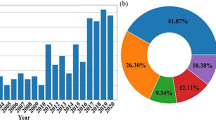Abstract
We extend and analyze the energy-based discontinuous Galerkin method for second order wave equations on staggered and structured meshes. By combining spatial staggering with local time-stepping near boundaries, the method overcomes the typical numerical stiffness associated with high order piecewise polynomial approximations. In one space dimension with periodic boundary conditions and suitably chosen numerical fluxes, we prove bounds on the spatial operators that establish stability for CFL numbers \(c \frac{\Delta t}{h} < C\) independent of order when stability-enhanced explicit time-stepping schemes of matching order are used. For problems on bounded domains and in higher dimensions we demonstrate numerically that one can march explicitly with large time steps at high order temporal and spatial accuracy.









Similar content being viewed by others
References
Appelö, D., Hagstrom, T.: A new discontinuous Galerkin formulation for wave equations in second order form. SIAM J. Numer. Anal. 53(6), 2705–2726 (2015)
Appelö, D., Hagstrom, T., Vargas, A.: Hermite methods for the scalar wave equation. SIAM J. Sci. Comput. 40(6), A3902–A3927 (2018)
Banks, J.W., Hagstrom, T.: On Galerkin difference methods. J. Comput. Phys. 313, 310–327 (2016)
Cockburn, B., Shu, C.-W.: TVB Runge–Kutta local projection discontinuous Galerkin finite element method for conservation laws. II. General framework. Math. Comput. 52(186), 411–435 (1989)
Diaz, J., Grote, M.: Energy conserving explicit local time stepping for second-order wave equations. SIAM J. Sci. Comput. 31(3), 1985–2014 (2009)
Hesthaven, J., Warburton, T.: Nodal high-order methods on unstructured grids: I. Time-domain solution of Maxwell’s equations. J. Comput. Phys. 181, 186–221 (2002)
Joly, P., Rodríguez, J.: Optimized higher order time discretization of second order hyperbolic problems: Construction and numerical study. J. Comput. Appl. Math. 234, 1953–1961 (2010)
Ketcheson, D., Lóczi, L., Kocsis, T.: On the absolute stability regions corresponding to partial sums of the exponential function. IMA J. Numer. Anal. 35(3), 1426–1455 (2015)
Kreiss, H.-O., Wu, L.: On the stability definition of difference approximations for the initial boundary value problem. Appl. Numer. Math. 12(1–3), 213–227 (1993)
Liu, Y., Shu, C.-W., Tadmor, E., Zhang, M.: L2 stability analysis of the central discontinuous Galerkin method and a comparison between the central and regular discontinuous Galerkin methods. ESAIM Math. Model. Numer. Anal. 42(4), 593–607 (2008)
Nessyahu, H., Tadmor, E.: Non-oscillatory central differencing for hyperbolic conservation laws. J. Comput. Phys. 87(2), 408–463 (1990)
Reyna, M., Li, F.: Operator bounds and time step conditions for the DG and central DG methods. J. Sci. Comput. 62(2), 532–554 (2015)
Warburton, T., Hagstrom, T.: Taming the CFL number for discontinuous Galerkin methods on structured meshes. SIAM J. Numer. Anal. 46(6), 3151–3180 (2008)
Funding
This work was partially supported by NSF Grant Nos. DMS-1913076, DMS-2012296, DMS-1719942, DMS-1913072 and DMS-2208164. Any opinions, findings, conclusions or recommendations expressed in this material are those of the authors and do not necessarily reflect the views of the National Science Foundation.
Author information
Authors and Affiliations
Corresponding author
Additional information
Communicated by Jan Nordström.
Publisher's Note
Springer Nature remains neutral with regard to jurisdictional claims in published maps and institutional affiliations.
Rights and permissions
Springer Nature or its licensor (e.g. a society or other partner) holds exclusive rights to this article under a publishing agreement with the author(s) or other rightsholder(s); author self-archiving of the accepted manuscript version of this article is solely governed by the terms of such publishing agreement and applicable law.
About this article
Cite this article
Appelö, D., Zhang, L., Hagstrom, T. et al. An energy-based discontinuous Galerkin method with tame CFL numbers for the wave equation. Bit Numer Math 63, 5 (2023). https://doi.org/10.1007/s10543-023-00954-2
Received:
Accepted:
Published:
DOI: https://doi.org/10.1007/s10543-023-00954-2




